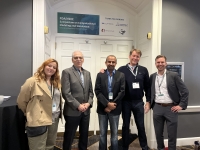The FDA/MDIC Symposium on Computational Modeling and Simulation (CM&S) in Washington DC (April 15-17, 2024) unfolded its vibrant tapestry for three enlightening days of interdisciplinary innovation and collaboration.

With over 220 participants, with roughly 68% from industry and 17% regulatory experts, the symposium also attracted international participants from over 29 countries. Europe constituted the majority of international attendees (non-U.S), with a significant presence from representatives from Avicenna Alliance and VPHi, who actively participated in the interactive sessions and panel discussions, echoing the need to elevate CM&S as a crucial component in regulatory processes.
Day 1: Training & workshop
The first day kicked off with a pre-symposium workshop, focusing on vital standards for the use of CM&S evidence for regulatory approvals. This included a workshop on the ASME V&V40 and the FDA Guidance documents on Modelling and Simulation.
Day 2: Symposium theme – ‘Generating Regulatory In-Silico Evidence’
The opening remarks from Dr. Ed Margerrison, Director OSEL set the scene as he emphasized the need for turning Modelling & Simulations from a scientific tool to a regulatory tool. He passionately called on the diverse stakeholders to help the community to develop standardized toolsets across the life cycle.
“Why should Clinicians Trust”
It was fitting to start the 2-day proceedings with the open question on “Why should Clinicians Trust CM&S”, in the context of using CM&S to guide clinical decision making. The real-world case studies presented from the Boston Children’s Hospital demonstrated the potential of engineers and clinicians joining forces for the planning and execution of clinical interventions. To navigate the long winding road to building trust, the experts highlighted the importance on stakeholder engagement to build on consensus in the community, which resonates well with the work VPHi continues to champion. The clinical session was followed by a fireside panel discussion on Credibility Assessment. FDA and industry representatives collectively walked through four different case studies and deliberated on the risk assessment score for the given context-of-use, within each case study. It demonstrated that regulators and technology developers had mixed reflections on the model influence and decision consequence scores, but offered insightful observations on credibility goals and comparators.
After the networking lunch, discussions started off with a group of panellists pondering the opportunities and challenges for CM&S. In discussions with the audience, they identified that ‘early product development’, ‘regulatory submission’ and ‘post-market surveillance’ are the biggest opportunities, while ‘budget and resource’, ‘interaction with cross-functional teams’ and the establishing ‘return-on-investment’ with senior leadership as points of concern.
The day wrapped up with a networking opportunity with over 30 poster presentations. The VPHi team presented the value of ecosystem organizations by showcasing the various initiatives of the institute such as the Good Simulation Practices (GSP), Clinical Survey and FAIR Sharing collection. Here you can find the VPHi poster.
Day 3: Simulation First - Digital Evidence for Digital Era
The third and last day of the symposium started bright and early with thought-provoking sessions on the vast opportunities and challenges within the realm of in silico medicine. Prof. Alex Frangi, presenting the “Digital Evidence for Digital Era”, enlightened the audience on the in-silico trial initiatives in the UK and Europe. Of specific interest, he presented the community with the pathway to explore simulation-first, before animal or clinical trials. Thus, in-silico trials as a means to de-risk real-world clinical trials.
Conrad Grant, Chief Engineer from the Johns Hopkins University Applied Physics Laboratory, illuminated the ‘Digital Twin’ initiative of National Academies, in the U.S. The concept of ‘Digital Twin’ and its definition, did spur interesting debate and questions on terminologies among the modellers and clinicians. Thus leading to apprehension on the level of interaction between physical and virtual twin, the need for standards for digital twin and when is the problem a good fit for ‘digital twin’. These transatlantic observations on ‘Digital Twin’ relate well to similar discussions noted during the public consultations on EDITH-CSA’s roadmap and ‘Virtual Human Twin’ engagements, in Europe. Once again, emphasis was placed on cross-stakeholder engagement, with a spotlight on the need for collaboration alongside patients.
The panel on Good Simulation Practice, led by Avicenna Alliance and VPHi colleagues, began with a self-reflection on what GSP means for individuals be it regulator from FDA or a technology developer, from industry. The panel extensively deliberated on possible ways for the M&S community to follow other fields (GLP, GMP, GCP) in order to foster the adoption of GSP. Of specific note, Dr. Tina Morrison, FDA, related GSP to GLP, whereby the former possibly helps with ‘running an accredited in-silico laboratory’ that regulators can inspect and GSP serves as a means to gain trust in CM&S based regulatory evidence.
Closing the symposium on a high note, a final panel session centred on the international state-of-the-art in CM&S as pivotal evidence for regulatory approvals. Among others, notified bodies from European member states took the stage, shedding light on the critical dialogue surrounding the models' limitations and paramount concerns for patient safety.
In conclusion, the 2024 FDA/MDIC symposium not only illuminated the cutting-edge advancements in CM&S across the globe but also underscored the imperative of interdisciplinary collaboration in shaping the future of healthcare innovation.